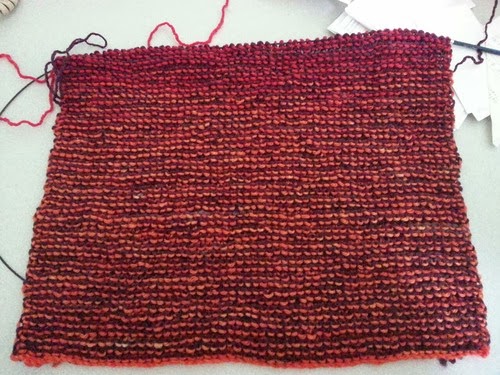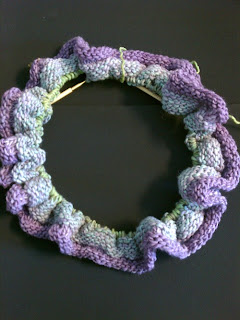Artist
Statement
Knitting is a hand looming
technique that uses a strand of fiber and two sticks to form and intertwine
loops in such a way that they create a stable and sometimes stretchy fabric. I knit
all the items I produce without using assistants or apprentices. All the
processes I use are manual processes or those that may use a very simple
apparatus such as a yarn swift and a ball winder. The stitch by stitch nature
of this process allows for fine control of the content and texture of the
fabric. The yarns I use are from all over the world and include, silk, wool,
cotton, linen, nylon, polyester, metallic fibers, viscose, tencel, acrylic,
alpaca, acetate, mohair, cashmere and rayon.
I knit in order to create beautiful
textiles in ancient forms such as wraps and scarves. I often seek a wide range of yarns, sometimes
more than 30 or 40 to create one fabric.
The colors and surface design of each piece grow through a duly
considered process of color and fiber selection and combination. In some pieces
it is important to select a smooth yarn that will highlight the fabric pattern.
In other pieces it is more desirable to use wildly different yarns with
extraordinary texture created by yarn combinations rather than a fabric
pattern. I am endlessly attracted to the combination of utility and beauty.
Bio: Lorre Smith
During an adolescence of artistic explorations with various media Lorre undertook private lessons in design from local artist Larry Banghart then progressed through various needle arts experiences in patchwork and quilting, embroidery, knitting, crochet, garment sewing and tailoring. After several weeks of intense instruction in arts and creativity from Oakland, CA artist Alan Leon during 2004, hand looming proceeded to take center stage, with occasional forays into drawing, painting, mixed media, assemblage and collage arts and just about all other fiber arts. Ongoing influences include English needlewoman Erica Wilson, English painter Kaffe Fasset, who has also explored fiber arts, Irish knitter and designer Maggie Jackson, and Alexander Calder, whose lesser known pieces include a series of fiber works. Her most recent knitting teacher is the English yarn and knitwear designer Louisa Harding.
She creates hand-loomed textiles using primitive tools: small sticks and hooks. By creating interlocking loops and combining many yarns, she develops sophisticated fabrics. Using primitive tools allows the most control over the way the yarns and threads fit together and the way the fiber colors blend or contrast with one another. She generally creates very simple shapes so that the textiles themselves are the fundamental essence of the art. She also creates textiles that are not possible to create by machine. The texture of the fabric is as important as its visual design qualities. Textiles can evoke serious, sensual or whimsical moods, and each person brings out various elements of their personality and appearance when wearing them. The colors and surface design of each piece grow through a considered process of color and fiber selection, a determination of how delicate or bulky the textile will be then how each yarn will be incorporated into the fabric. In some pieces it is important to select a smooth yarn that will highlight the fabric pattern. In other pieces it is more desirable to use wildly different yarns with extraordinary texture created by yarn combinations rather than a fabric pattern.
Lorre’s work is available at:
LOCAL in Lenox, Massachusettes;
Lorre documents the on-going progress of her work in two blogs:
January 2013

















































